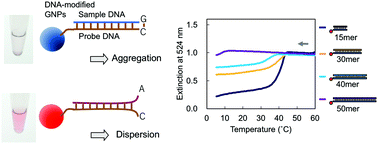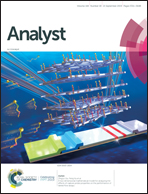Characterizing the non-crosslinked aggregation of DNA-modified gold nanoparticles: effects of DNA length and terminal base pair†
Abstract
We previously reported that fully complementary DNA duplexes formed on gold nanoparticle (GNP) surfaces aggregate at high salt concentrations. We previously reported that DNA-functionalized gold nanoparticles (GNPs) aggregate by hybridization with fully complementary DNA at high salt concentrations. Although this behavior has been applied to some precise naked-eye colorimetric analyses of DNA-related molecules, the aggregation mechanism is still unclear and comprehensive studies are needed. In this paper, we reveal the key factors that influence GNP aggregation. The effects of temperature, electrolyte concentration, probe length, and particle size, which control the stabilities of double-stranded DNAs and GNPs, were investigated. Larger GNPs aggregated more easily, and GNP aggregates were easily formed with ∼15-mer-long probes, while longer probes prevented aggregation, perhaps by preventing the formation of rigid double-stranded DNA layers, compared to shorter probes. Furthermore, GNPs with purine bases at their 5′ ends aggregated more easily than those with these bases at their 3′ ends. This phenomenon is different from that based on the melting-temperature trend calculated using the nearest-neighbor method.



 Please wait while we load your content...
Please wait while we load your content...